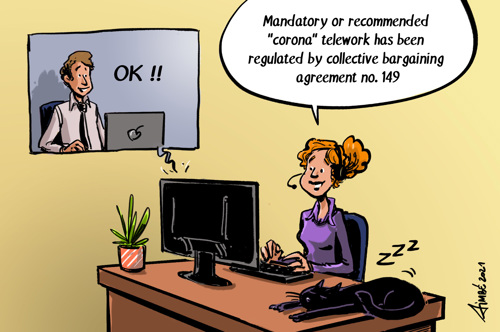- Employment Law
- telework , teleworking , recommended telework , mandatory telework , CLA no. 149 , corona , corona crisis
During the corona health crisis, mandatory and/or recommended telework became practically the rule. With the collective bargaining agreement no. 149 of 26 January 2021, the National Labour Council has given this regulation a legal framework.
This (temporary) collective bargaining agreement (hereinafter CLA) regulates the telework made compulsory or recommended by the government during the Covid-19 health crisis.
1. When does CLA no. 149 apply?
This CLA applies to employers who, as at 1 January 2021, have not yet provided for a regulation on teleworking.
The CLA therefore does not apply to existing collective agreements, individual agreements on telework or telework policies that have been concluded or adopted in companies before 1 January 2021. This means that existing agreements on teleworking continue to apply in situations where the government strongly recommends or imposes teleworking as part of the measures to combat the coronavirus.
Teleworking on a regular basis in the private sector was already regulated by CLA no. 85.
The CLA no. 149 therefore does not prevent, within the company, the elaboration of an instrument of indefinite duration, for example, with a view to structural telework within the framework of the CLA no. 85 on telework.
Collective agreement no. 149 is therefore a temporary collective agreement of a supplementary nature, effective from 26 January 2021 to 31 December 2021.

2. What does CLA no. 149 include?
This CLA includes, on the one hand, (i) the principles and a reference framework for telework during the coronacrisis and, on the other hand, (ii) a policy for well-being at work specifically related to telework.
2.1 Principles and reference framework for telework during the coronacrisis
The CLA provides principles and a frame of reference that clarify certain points that companies must take into account when concluding agreements on telework during the coronacrisis.
2.1.1 The principles
The first principle is that the teleworker has the same rights and obligations with regard to working conditions as those applied when he is employed on the employer's premises.
The second principle requires that the teleworker is informed, where appropriate, in particular about specific working conditions, complementary or derogatory to those applied when employed on the employer's premises.
2.1.2 Agreements concluded in the context of telework
The agreements envisaged include
- the provision by the employer of the equipment and technical support needed in the context of teleworking (e.g. when a laptop computer is provided),
- the payment by the employer of the cost of installing relevant computer programs, the costs of use, operation, maintenance and depreciation where the teleworker uses his own equipment and
- the additional costs to be connected.
These arrangements take into account the more global framework of all the costs or compensations paid by the employer to the teleworker during the coronacrisis.
2.1.3 Organisation and control of telework
The collective agreement also states that the teleworker manages the organisation of his/her work within the framework of the working time applicable in the company. The teleworker's workload and performance standards are also supposed to be equivalent to those applied when he/she is employed at the employer's premises.
However, the employer has the possibility to exercise adequate and proportionate control over the results and/or performance of the work. The teleworker shall be informed by the employer of how such monitoring is carried out, if appropriate. For the employer, this is not a matter of continuous control, but of being able to check, in an appropriate and proportionate way, whether the work that must be done in the context of teleworking has actually been done correctly.
The collective agreement also provides for the possibility of making arrangements on the accessibility and unavailability of the teleworker. In other words, it must be agreed at what times and periods the teleworker must be reachable or may be unreachable during the working time applicable in the company. The reconciliation of telework and private life has to be taken into account, given the particularity of performing telework in a private environment.
2.2 Workplace well-being policy specific to telework
In addition to the principles and a reference framework for telework, the collective agreement provides for a policy on well-being at work specifically related to telework.
This part of the CLA provides a concise summary of the existing legal provisions on well-being at work and certain elements related to the specificity of the CLA. It also serves as a manual and guideline for the companies that apply the collective agreement.
2.2.1 The employer informs the teleworkers
The employer must inform the teleworker about the company policy on well-being at work specifically elaborated in the case of telework.
This concerns more precisely information and instructions concerning preventive measures, in particular on the installation of the workplace, on the correct use of display screens and the technical and IT support available. Such information, instructions and preventive measures are based on a multidisciplinary risk analysis. This risk analysis also takes into account the psychosocial dimension as well as the health aspects related to telework, including the possibility of informal or formal psychosocial intervention and the possibility of consulting the prevention advisor/occupational health physician spontaneously.
The employer also informs the teleworkers of the names and contact details and the support provided by
- the immediate supervisor;
- the prevention advisers responsible for occupational safety, occupational medicine and psychosocial aspects of the internal or external prevention service, and
- where appropriate, the counselor.
Teleworkers can contact these people in an "appropriate way", e.g., by sending photos or via video conferencing from the workplace. If necessary, adjustments to the workstation can be proposed. In view of the health situation, visits by prevention services are not appropriate.
The employer has to provide information to the line manager and the teleworkers and, if required, provide for appropriate training on the modalities and specificities of telework.
2.2.2 The employer must take appropriate measures
Finally, the collective agreement obliges the employer to take appropriate measures to maintain teleworkers’ attachment with their colleagues and to the company, and to prevent isolation.
In doing so, the employer must pay particular attention to vulnerable teleworkers. The term "vulnerable teleworkers" refers to teleworkers whose personal, family and/or housing situation, for example, may cause additional pressure during telework.
The employer can also, inter alia, plan well-organised and limited return moments for the teleworkers while respecting the applicable sanitary rules.
3. How is CLA no. 149 implemented?
The application of CLA no. 149 does not require an annex to the employment contract, contrary to what is required by CLA no. 85. The agreements concerning telework can be laid down in a collective agreement at company level, an individual agreement or in the work regulations or a policy.



